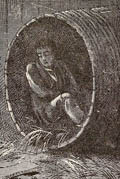|
Though the elevation of the pass is nearly 8,000 feet above the ocean level, I never endured heat exceeding that of yesterday in and about the station tent. The sun rose clear, as it almost always does here in summer, soon dispelling the chill which attends every night in this region; and by nine o'clock the heat was most intense. But the afternoon brought clouds, a wind and a petty rain squall, and the following night was cold enough to still any mosquitoes but those of the Rocky Mountains. I suspect these would sing and bite even with the mercury at zero. Toward evening, I climbed the hill on the east of the canyon, and obtained from its summit a wide prospect, but how desolate! These hills are of volcanic formation, a kind of coarse slate, the strata upheaved almost perpendicularly, the surface shattered and shingly, with veins of hard quartz running across them. There is scarcely a bushel of soil to each square rod, of course no grass, and little vegetation of any kind. To the north, say ten to twenty miles away, is a snow-streaked range of the Rocky Mountains; to the south, some miles across the Sweetwater, are lower and less barren hills, with some snowbanks and some wood--quaking asp and yellow pine--on their northern slopes. The Sweetwater heads among the mountains to the north and northwest. There is a little well-gnawed grass on its immediate banks and on those of its tributaries--on the high rolling land which fills all beside of the wide space between the mountains north and those south, there is not a mule feed to each acre. Some greasewood at intervals, the eternal sagebrush, and a few weeds, with the quaking asp and yellow pine aforesaid, and a thick tangle of bitter cottonwood (which is a bad caricature of our swamp alder) thatching portions of a few of the smaller streams, comprise the entire vegetation of this forlorn region. We started at seven this morning, came down to the old Salt Lake, Oregon, and California Trail at the Sweetwater, crossed and left that creek finally, and traversed a slightly rolling country for seven miles to the Twin Buttes, two low, clay-topped mounds which mark the point from which the water runs easterly to the Gulf of Mexico, and westerly to the Pacific. If anyone has pictured to himself the South Pass as threading some narrow, winding, difficult, rocky mountain gorge, he is grievously mistaken. The trail through the South Pass is the best part of the route from Atchison to California; the clay has here been almost wholly washed away and carried off, so that the road passes over a coarse, heavy, gravelly sand, usually as compact and smooth as the best illustrations of the genius of McAdam. I never before traversed forty-five miles of purely natural road so faultless as that through the South Pass which I have traveled today. But this tract would be good for roads, as it seems absolutely good for nothing else. The natural obstacles to constructing a railroad through this region are not comparable to those overcome in the construction of the Camden and Amboy. |
